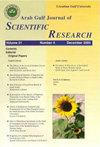Steady state modeling of autotrophic membrane bioreactor – a new approach to quantify biomass
Q4 Business, Management and Accounting
引用次数: 0
Abstract
PurposeThe main purpose of this study resides essentially in the development of a new tool to quantify the biomass in the bioreactor operating under steady state conditions.Design/methodology/approachModeling is the most relevant tool for understanding the functioning of some complex processes such as biological wastewater treatment. A steady state model equation of activated sludge model 1 (ASM1) was developed, especially for autotrophic biomass (XBA) and for oxygen uptake rate (OUR). Furthermore, a respirometric measurement, under steady state and endogenous conditions, was used as a new tool for quantifying the viable biomass concentration in the bioreactor.FindingsThe developed steady state equations simplified the sensitivity analysis and allowed the autotrophic biomass (XBA) quantification. Indeed, the XBA concentration was approximately 212 mg COD/L and 454 mgCOD/L for SRT, equal to 20 and 40 d, respectively. Under the steady state condition, monitoring of endogenous OUR permitted biomass quantification in the bioreactor. Comparing XBA obtained by the steady state equation and respirometric tool indicated a percentage deviation of about 3 to 13%. Modeling bioreactor using GPS-X showed an excellent agreement between simulation and experimental measurements concerning the XBA evolution.Originality/valueThese results confirmed the importance of respirometric measurements as a simple and available tool for quantifying biomass.自养膜生物反应器稳态建模——一种量化生物量的新方法
本研究的主要目的在于开发一种新的工具来量化在稳态条件下运行的生物反应器中的生物量。设计/方法论/方法建模是理解一些复杂过程(如生物废水处理)的功能的最相关的工具。建立了活性污泥模型1 (ASM1)稳态模型方程,特别是自养生物量(XBA)和氧吸收率(OUR)。此外,在稳态和内源条件下,采用呼吸测量法作为定量生物反应器中活生物量浓度的新工具。结果建立的稳态方程简化了敏感性分析,使自养生物量(XBA)定量成为可能。实际上,SRT的XBA浓度约为212 mgCOD/L和454 mgCOD/L,分别等于20和40 d。在稳态条件下,监测内源OUR允许生物反应器中的生物量定量。通过比较稳态方程和呼吸计得到的XBA,结果表明,两者之间的误差约为3% ~ 13%。利用GPS-X对生物反应器进行建模,模拟结果与实验结果吻合良好。原创性/价值这些结果证实了呼吸测量作为量化生物量的一种简单而有效的工具的重要性。
本文章由计算机程序翻译,如有差异,请以英文原文为准。
求助全文
约1分钟内获得全文
求助全文
来源期刊

Arab Gulf Journal of Scientific Research
综合性期刊-综合性期刊
CiteScore
1.00
自引率
0.00%
发文量
0
审稿时长
>12 weeks
期刊介绍:
Information not localized
 求助内容:
求助内容: 应助结果提醒方式:
应助结果提醒方式:


